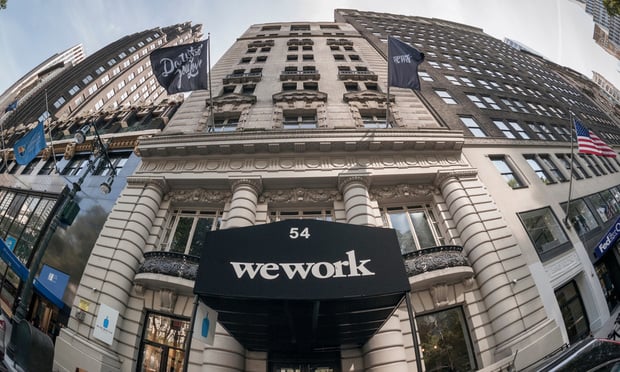LOS ANGELES—Flex space could account for 13%, or nearly 600 million square feet of total US office supply by 2030, according to a recent report on the asset class by CBRE.
As this category grows, its model is shifting to take into account more innovative lease structures. As they do, the capital markets are watching closely, unsure of what these changes could mean to buildings' valuations.
There is reason for some concern on valuations. Eventually, CBRE predicts in its report, there likely will be far fewer traditional leases between landlords and operators with more onus on landlords to accept and manage risk.
For example, today most third-party operators enter into a traditional long-term lease agreement with the landlord. In the future, CBRE forecasts, the third-party operator and landlord will be just as, if not more, likely to enter into a partnership agreement sharing any profit and loss. We are already seeing this model at work at 75 Rockefeller Plaza in New York City, between WeWork and RXR.
WeWork and Everyone Else
Indeed, WeWork is a leader in the flex office space in terms of size and growth with nearly 11 million square feet added to its portfolio since Q2 2018, CBRE reports. However, change in the flex model is also being driven by smaller—even the smallest—of competitors. Spaces and Knotel are two more major operators, each adding more than 1 million square feet during that same time period. And smaller players such as CommonGrounds are securing venture capital to fund rapid growth.
All told, there are hundreds of flexible space operators in the ethos right now, Julie Whelan, CBRE's Americas Head of Occupier Research, tells GlobeSt.com. "These bold operators that are beginning to forge the next generation of flexible office space aren't always the biggest but they are the ones thinking critically about what will sustain them into the future," she says.
"Both consumer demand and therefore property markets have cycles that flexible space operators must contend with. This reality is causing an evolution towards landlord partnerships, owner-operated space and even franchise agreements taking the place of traditional lease agreements," she concludes.
Many Variations of the Model
To be sure, flex office space only takes up a small percentage of the overall market. To reach 20% or more of total supply by 2030 would require a large conversion of traditional corporate leased space into flexible space, CBRE said, noting that although flexible office supply grew by 34% for the year ending Q2 2019, it still accounts for just under 2% of total US office inventory. The two most penetrated and high-growth markets in the U.S.—San Francisco (4%) and Manhattan (3.6%)—have yet to reach the 6% level achieved in London and Shanghai.
Within this relatively small percentage of flex offerings though, different variations of the model are beginning to emerge. Some landlords are even introducing flex offerings under their own brands. Although traditional leases remain most prevalent, partnership and operating agreements between landlords and third-party flex operators are growing in popularity with landlords such as Hines and RXR Realty pioneering these deals, CBRE said. Concurrently, some landlords are introducing their own flex offerings, such as Studio by Tishman Speyer and Flex by BXP (Boston Properties).
Eventually, CBRE posits, the capital markets will evolve their valuation models in turn. One significant drawback right now is that it can be difficult for capital market to value and understand these models.
Research Points to Favorable Valuations
However the research in this space to date does point to ultimately favorable valuations for properties with flex office space. A report earlier this year from CBRE looked at office transactions, and found that 40% of buildings with flexible space traded at a higher value than the average office building in the market while 52% of buildings traded on par with the market average. This was, though, not a definitive link. As CBRE pointed out, flexible space is more common in newer or renovated office buildings, and that could account for the boost in pricing among some of the properties. Also, office spaces in general have seen an upward trend in pricing as well.
Still, as flex office space becomes more mainstream, lenders and investors are starting to see the benefits of moderate exposure as part of a well-diversified tenant roster, according to Alex Colpaert, Head of Offices Research at JLL EMEA. In short, he wrote in a research note, buildings with a high percentage of flexible space are increasingly seen as viable investment propositions. This is a point also found in Deloitte's 2019 Commercial Real Estate Outlook, which said that these newer opportunities may be more ideal for investors. "Investors seem to realize that their investments should be tied to the changing nature of work and tenant preferences," Deloitte wrote in its report. "As such, the new capital commitment is unlikely to flow entirely into traditional CRE."
Deloitte found that over half of investors it surveyed have plans to invest or increase investments in properties with flexible leases, and 44% plan to do so for flexible spaces. In general, survey respondents specializing in mixed-use and nontraditional properties plan to increase their capital commitment by a higher percentage than those focused on traditional properties.
© Touchpoint Markets, All Rights Reserved. Request academic re-use from www.copyright.com. All other uses, submit a request to [email protected]. For more inforrmation visit Asset & Logo Licensing.








